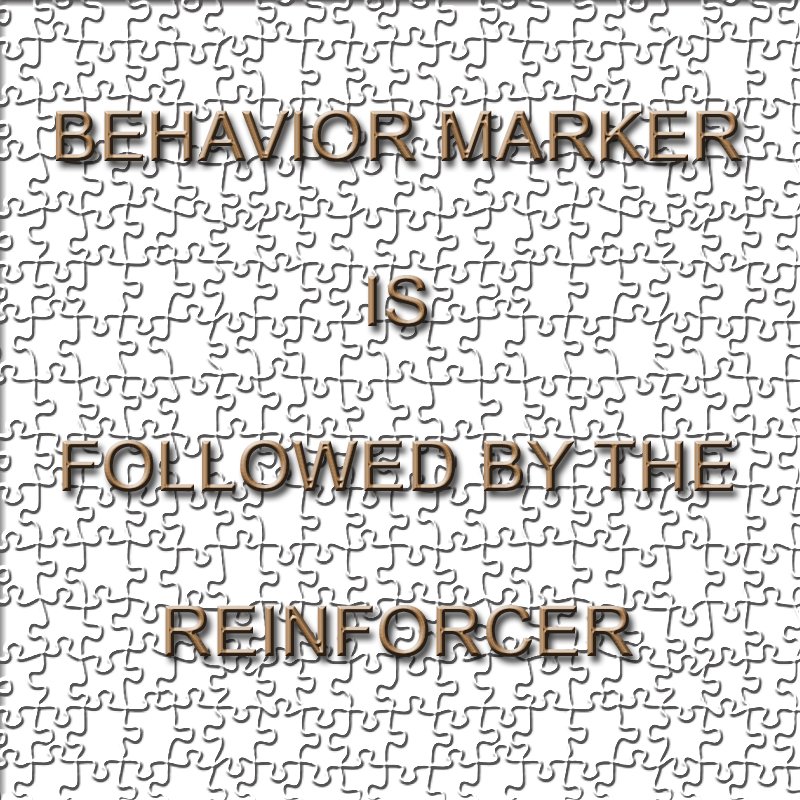Behavior - the aggregate of responses to internal and external stimuli.
Marker - something used as a mark or indication,
Behavior markers - a sound, visual or word paired reliably with a reward to mark a precise moment of successful action.
Behavior markers are used when teaching a new behavior or modifying and existing behavior. Once it is a reliable behavior the “marker” is weaned off or used to fine tune behavior evolution.
So what does all of this mean? I am passionate about behavior markers. Even though I am very PRO behavior marker, I don’t always teach them. I will often talk around them and watch as my client either leans in for more, or out to get away from the difficulty. I get it, not everyone wants to know more. As a trainer, it is essential to give people what they will use. That may be simply to keep it as easy as possible. If your client is not willing to use, learn or embrace a behavior marker; then teaching it is a huge waste of time for everyone involved.
Okay, so why is the behavior marker so great and exactly what is it? I have given the dictionary meaning above but it can be a tough concept to grasp, that is until you start to use it.
I am seeing people try to use behavior markers more and more; and, I am also seeing behavior markers used incorrectly more and more. To use a behavior marker successfully, you have to learn a few basics and adhere to them.
Let’s have a quick look at where behavior markers came from B.F. Skinner began his work with operant conditioning and the marker in the 30s. It has since evolved and is now widely used by many R+ trainers. Karen Pryor introduced the clicker and it took off with loads of animal trainers.
Training staff at large aquariums use it to train their dolphins, seals and other animals as it is difficult to deliver a reward at the precisely correct time unless they utilize markers, whistles. Imagine that the teacher wants a dolphin to leap very high through a hoop. You can’t be up in the air to reward the hoop leap but you can mark it and reinforce it when the dolphin comes back down.
You need to super charge (create a connection between) your marker and reinforcer.
Reinforcer - A stimulus, such as a reward, that in operant conditioning maintains or strengthens a desired response.
Watching behavior markers at work is fascinating. Here are a few important things to remember.
Important stuff
Timing is everything with behavior markers. The marker offers you a way to time let your dog know precisely when they are offering a behavior you want. Learning how important this is comes with experience.
A behavior marker MUST be followed by the reinforcer always. Otherwise it looses its strength. The marker is not the reward, this is one of the biggest mistakes I see. People clicking through training and not following the click with the reward or reinforcer.
Just clicking or marking willy nilly is not the idea.
Once a behavior is learned, we wean off of the behavior marker and replace with verbal praise and random rewards.
The reinforcer (food, ball, tug etc.) must come after the marker. It does not have to be immediate but should be related to the “marked” behavior in a timely manner; typically a few seconds.
Verbal cue is not added until the behavior is set (the dog clearly understands and offers the behavior.)
Example
Behavior marker, let’s use the word “key” as our example (it can be a sound, word or visual (flashlight.))
Reinforcer, let’s use food as our example (can use food or anything the dog would consider as a reward, like a ball or tug as well.)
“key” = food coming
We start with the dog sitting in front of us; say “key” and give the food. “Key” give food, “key” give food, “key” give food. I like to do it about 10 times in a row or until I see a bit of an AH HA moment from the dog. Dog figures out the marker word “key” means food.
Teaching place. Put a rug, blanket, towel or pad on the floor. When your dog sniffs it, “key” and toss the reward about 3 feet away. Do this until your dog is going to the “place” each time. Tossing the reward creates a situation for your dog to continue offering the “marked” behavior.
Once your dog is reliably returning to “place” then up your criteria. Dog must now put a foot on the “place.” Lots of patience and waiting for dog to offer new criteria behavior. When they do “key” and toss reward.
Next is two feet on place. Then four feet, then four feet and a sit, then a down. Each progression is marked and reinforced. When you up the criteria, you wait for your dog to offer it. You can help out at times when you want a sit and add it quickly before marking and reinforcing.
Once you have a reliable :”place” you can add the verbal cue (more on that later.) Then drop the behavior marker. Rewards will be weaned off, depending on the dog. That means praise between treats to get space between rewards. At that point you wean treats; but never forget to tell your dog that they are doing a great job and thank them for it.
Training is an evolution, it is not a one and done thing.
As always, if you have any questions, please ask away.

